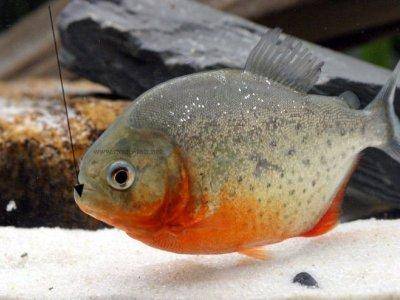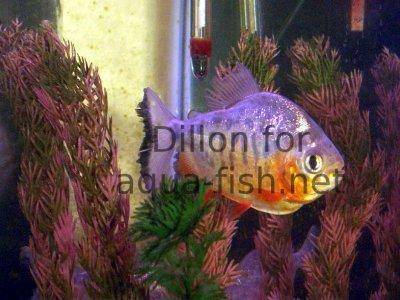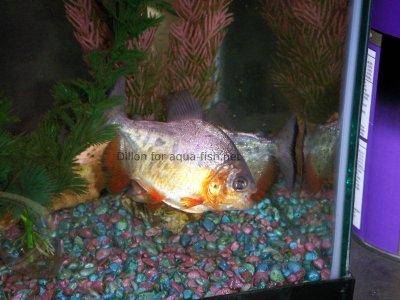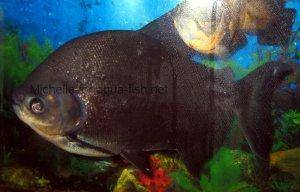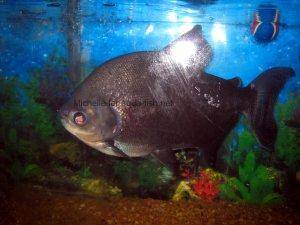Pacu Fish Care Guide: Tips, Images, and Common Issues
Quick links - Answers
Brief Description
This page is dedicated to raising Pacu fish in aquariums and garden ponds. It's also a space for sharing your experiences and asking questions! We'd love to hear about your Pacu, so please share your story using the form at the bottom of this page. Additionally, you might find these pages helpful: Black Pacu - Colossoma macropomum Profile and Red-Bellied Pacu - Piaractus brachypomus Profile.
Pacu: The Charmer
One of the first fish I ever owned was a Red-Bellied Pacu. I was drawn to them because of their natural appearance and lively swimming behavior. After a meal, they would chase each other around the tank, almost as if playing tag. Their powerful swimming abilities are evident as they navigate through the water, enjoying the space to interact with other Pacus. When first introduced to a tank, you might notice their skittish behavior in response to sudden movements. Like their piranha relatives, Pacus appreciate rocks, plants, and other decorations to hide behind, which helps them feel secure.
Pacu vs. Red-Bellied Piranha
Red-Bellied Pacus are often confused with their cousins, the Red-Bellied Piranhas, particularly when they are juveniles. Sometimes, Red-Bellied Piranhas are mistakenly sold as Pacus due to the difficulty in distinguishing between the two. The images below illustrate a simple way to tell them apart.
Red-Bellied Piranha
Notice the larger underbite and the more pronounced lower jaw of the piranha.
Red-Bellied Pacu
Although this fish is younger than the piranha above, it exhibits similar colors and shares some body shape characteristics.
Tank Mates
Choosing tank mates for the Red-Bellied Pacu can be challenging. Although they are not highly aggressive, they will eat smaller fish that fit in their mouths and will often outgrow other species. It is not uncommon for a Pacu to get along with a tank mate for a long time, only to later find the smaller fish missing and the Pacu with a full belly. While cichlids are sometimes considered suitable tank mates, many species are too aggressive for Pacus. Opting for larger, peaceful fish is generally the best approach.
Feeding
Pacus are primarily herbivores, so live plants typically do not last long in their tank. Artificial plants are a better option as they are more durable and easier to maintain. Pacus are known for their varied diet and are among the least picky fish I've encountered. They can be fed lettuce, chicken, goldfish feeders, fish flakes, pellets, and shrimp, especially when they are larger. Feeding time is particularly energetic, with Pacus often playing and chasing each other even after the food is gone. In the photo below, you can see them circling each other with their mouths open wide.
Not a Small Fish
Many people visit pet stores and see Pacu fish that are only the size of a quarter, not realizing how large and fast they will grow. They often buy 3-4 Pacus for a 10-gallon (~38 liters, 8.33 Imperial gallons) tank, only to return to the pet store within a few months to upgrade to a larger tank. Pacus can grow into giants, reaching up to 2 feet long (60 cm) if given the proper tank setup. This means you'll eventually need a 250-gallon (~946 liters, 208 Imperial gallons) aquarium. Keep this in mind if you plan to keep these potentially enormous fish. Additionally, Pacus have a long lifespan, typically living 12-14 years.
Tank Requirements
As noted, you'll need a tank of about 250 gallons (~946 liters, 208 Imperial gallons), so plan accordingly before acquiring these fish. A suitable filtration system should include more than one filter to handle their waste. The water temperature should be maintained around 79°F (26°C) to prevent disease. If the temperature exceeds this range, the Pacu may face lower oxygen levels in the water, which is detrimental. It’s crucial to keep the temperature stable, as rapid changes, even gradual for other fish, can be harmful or fatal to Pacus.
Pacu: The Re-decorator
As they grow larger, Pacus can start rearranging things in their aquarium. They might knock heaters off their mounts or topple rock formations, causing potential damage. To prevent issues, ensure all decorations are securely placed and stable. Blocking the heater with a rock or driftwood can protect both your Pacus and the heater from damage.
Breeding
Pacu fish are unlikely to breed in a home aquarium. Most are sourced from large farms with extensive ponds. Pacus lay thousands of eggs and often attempt to eat them immediately. If you have a very large tank and they do breed, it's essential to separate the parents from the eggs to ensure the survival of the offspring.
My Favorite Fish
Pacus are truly enjoyable fish. Take time to observe their unique behaviors and interactions. Unlike many fish that may seem unsocial, Pacus have engaging personalities and will likely become one of your favorite aquarium inhabitants.







